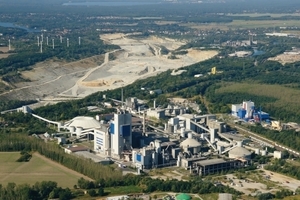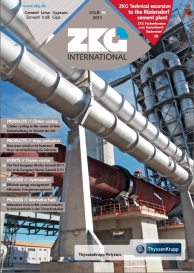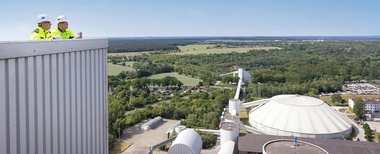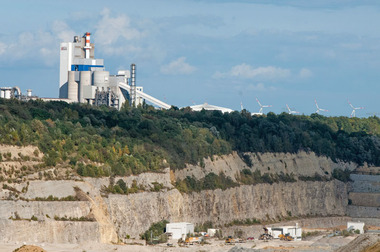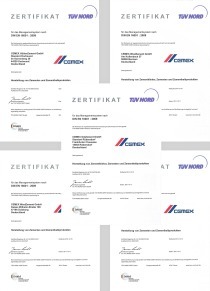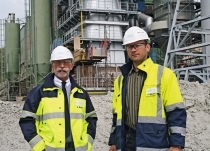Rüdersdorf: a cradle of the German lime and cement industry
The ZKG students‘ field trip took place between 14th and 16th June 2011, this time in co-operation with CEMEX OstZement GmbH, Rüdersdorf Works (Fig. 1). Almost 50 students from the RWTH Aachen and from Cottbus spent two days at one of the most versatile factories in Europe, gathering information about current requirements placed on plant and process technology.
On 15.06.2011, the programme commenced with the presentation “An Introduction to the Group and the Rüdersdorf factory” by Hans-Dieter Grudno, Managing Drector of Cemex OstZement GmbH, Werk Rüdersdorf. Rüdersdorf (Figs. 2-4), is one of the earliest locations of the German lime and cement industry. Limestone has been quarried here for over 750 years and the first cement factory was built in 1885. The present company‘s legal predecessor, Readymix, took over the Rüdersdorf cement factory in 1989 and continuously invested in the location. The most significant modernisation measures were the restructuring of the limestone quarrying and preparation systems, construction of the new production line No. 5 and modernization of the cement grinding, storage and dispatch systems. The Rüdersdorf plant burns three clinker qualities and manufactures a total of 11 cement types (CEM I, CEM II, CEM III). The product portfolio is rounded off by special building materials and limestone meal. Bulk products are transported by roadtankers and railway tank wagon, as well as in 25 kg bags. Herr Grudno then provided details about kiln line 5. In Rüdersdorf, more than 60 % of the required heat is input into the calciner of the preheater tower. The centrepiece of the Rüdersdorf system is a circulating fluidized bed (CFB). The employed primary fuels are hard coal, lignite and natural gas (only for heating-up). Secondary fuels are used in the CFB, the calciner and the clinkering zone burner.
The cement grinding plant comprises two grinding systems equipped with roller presses and one ball mill and separator. The roller presses are each equipped with separator circuits and installed downstream of 2 parallel single-pass ball mill circuits. The grinding systems and conveyor lines are dedusted by bag filters. The finished material is transported to the cement silos via diverse conveying equipment. Extremely high importance is placed on occupational safety. Herr Grudno stated that the number of industrial accidents had continuously decreased since 2002.
The next lecturer was Raymond Haböck of Siemens AG, Leipzig, with a presentation on the subject of “Electro-technical System Engineering on the Cement Manufacturing Sector”. He described the SICEMENTCIS system family that is very successfully employed in the cement industry. Siemens provides the cement industry with tailored solutions on the sectors of power, CEMAT, instrumentation, drives, BoP (Balance of Plants) and IT. Herr Haböck showed examples of how these systems are successfully employed in factories all around the world.
Next, Marieke Walter and Matthias Raabe gave presentations relating to Claudius Peters Projects GmbH. Frau Walter‘s lecture dealt with “Silo Technology and Fundamentals of Pneumatic Conveying”. After a brief overview of the company‘s history, she introduced a number of products, such as the vertical ball ring mill, packing systems and material storage systems. Claudius Peters‘ test plant facility performs small-scale tests for mills, packing machines, pressure vessels, X-pumps, silos and the Fluidcon conveying system, providing important data for the system design departments. Claudius-Peters equipment installed in Rüdersdorf include the clinker cooler, silo systems and pneumatic conveyors e.g. for transporting coal dust. Following that, an overview of possible applications for different conveying systems was presented.
After lunch, the topic was “The Use of Gravimetric Dosing Technology for Energy Efficiency and Process Safety in Cement Production”, a presentation by Johann Seiler of FLSmidth Pfister GmbH, Augsburg. For more than 100 years now, FLSmidth Pfister has been supplying continuous dosing systems for a wide range of applications in the feeding of fuels and dusts. Next, Peter Ripp dealt with the fundamental criteria that process engineers and mechanical engineers have to take into consideration when planning and designing plant components.
The participants had an afternoon tour of the factory under the leadership of Peter Scur and Ellen Wanzura. An evening event in Berlin provided a good opportunity for the attendees to build on what they had heard and to make new contacts.
The second day also had a full programme of lectures. Jens Breidenbach of Humboldt Wedag GmbH, Cologne spoke about “Pyroprocess Engineering in a Modern Cement Factory”. The Cologne plant engineering company provides technology and engineering from the quarry right through to the packing plant. Own-name equipment can be supplied for around 55 % of the systems and the rest is outsourced. Breidenbach particularly focused on the processes handled by KHD‘s core technology, in the cyclone preheater operating with the counterflow principle. A special cyclone design assures a low pressure drop and high system efficiency. The KHD precalcination system can be supplied in different configurations to suit customer requirements, e.g. equipped with emission-reducing LowNOx calciner or as a very flexible variant equipped with Combustion Chamber calciner for burning lumpy to large-sized surrogate fuel.
ThyssenKrupp Polysius AG, Beckum was represented by Eike Willms and Kerstin Rößler. In his lecture, “Clinker Burning – Fundamentals and Emissions” Willms provided more details of the requirement profile for modern cement factories. After a short introduction of the Polysius Group he focused on the individual plant components in the overall cement manufacturing process. In addition to turnkey systems for the cement industry, Polysius provides analysis systems of the POLAB® series for characterizing raw materials, raw meal, clinker and cement. Willms also spoke about relevant process engineering aspects for the designing of cyclones. A modular calcining system design enabled precise adaptation to the boundary conditions of production technology, such as nature of combustion, fuel mixture, gas velocities, material transportation and dwell times. Finally, the circulation of materials in rotary kilns and the CO2 reduction potential in cement factories was discussed.
Nearing the end of the programme, Dr. Ulrich Zielinski, Area Sales Manager Central and Eastern Europe of Refratechnik Cement GmbH, Göttingen presented “Refratechnik Refractory Materials – Innovations for the Cement Industry”, in which he showed how plant owner can cut costs and optimize processes by making the right choice of refractory lining. The main demands imposed on new types of brick are increased infiltration resistance, reduced gas permeability, long-term brick flexibility (thermal fatigue resistance) and improved brick strength (cold crushing strength). Surrogate fuels seriously stress a kiln system, necessitating the use of specially adapted refractory lining solutions in different sections of the system. This affects the selection of both the brick type and the brick geometry.
Jana Rosendahl from Cemex spoke about the staff requirement profile from the point of view of HR Management. Besides other opportunities, Cemex has a one-year trainee program for the areas Aggregates, Cement Operations and Generalist Functions. Multinational groups are constantly on the lookout for committed and competent staff for the whole spectrum of their business segments.
The next ZKG field trip for students is already being planned. We kindly request interested factories and companies to get in touch with Christian Reinke(Christian.Reinke@bauverlag.de).

